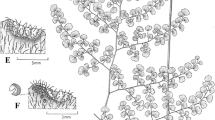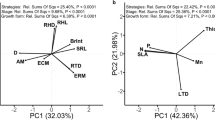Abstract
Key message
Fascicle types differed morphologically but had similar photosynthetic capacity on a surface area basis.
Abstract
In Pinus species, fascicles can develop with a different number of needles than what is typical. For example, Pinus taeda fascicles typically have three needles, but sometimes have two or four. Although differing fascicle morphology could be a response to changes in the environment designed to optimize carbon gain or minimize water loss, we are unaware of any work comparing physiological differences between fascicles with different numbers of needles. We compared the physiological and morphological characteristics of three- and four-needle fascicles of a loblolly pine clone with an abnormally high abundance of four-needle fascicles to better understand whether differences in needle morphology affected photosynthetic capacity or transpiration. Three- and four-needle fascicles had equal length, diameter, and volume, but four-needle fascicles had significantly greater surface area, mass, and tissue density. Equal fascicle total volume resulted in smaller per-needle volume in four-needle fascicles compared to three-needle fascicles. On a unit surface area basis, light-saturated net assimilation, stomatal conductance and transpiration were similar between the three- and four-needle fascicles although the maximum rate of carboxylation was significantly greater in four-needle fascicles. On a per-fascicle basis, four-needle fascicles had greater transpiration, stomatal conductance, and maximum rate of light-saturated net assimilation. Our results suggest that several factors, including increased tissue density and stomatal density, offset the reduction in needle volume in four-needle fascicles, resulting in similar levels of gas exchange per unit surface area in three- and four-needle fascicles.



Similar content being viewed by others
References
Akers MK, Kane M, Zhao D, Teskey RO, Daniels RF (2013) Effects of planting density and cultural intensity on stand and crown attributes of mid-rotation loblolly pine plantations. Forest Ecol Manag 310:468–475
Aspinwall MJ, King JS, McKeand SE, Domec J-C (2011) Leaf-level gas-exchange uniformity and photosynthetic capacity among loblolly pine (Pinus taeda L.) genotypes of contrasting inherent genetic variation. Tree Physiol 31:78–91
Brodribb TJ, Feild TS, Jordan GJ (2007) Leaf maximum photosynthetic rate and venation are linked by hydraulics. Plant Physiol 144:1890–1898
Cescatti A, Zorer R (2003) Structural acclimation and radiation regime of silver fir (Abies alba Mill.) shoots along a light gradient. Plant Cell Environ 26:429–442
Cole KL, Fisher J, Arundel ST, Cannella J, Swift S (2008) Geographical and climatic limits of needle types of one- and two-needled pinyon pines. J Biogeogr 35:257–269
Cregg BM (1994) Carbon allocation, gas exchange, and needle morphology of Pinus ponderosa genotypes known to differ in growth and survival under imposed drought. Tree Physiol 14:883–898
de Lobo F, de Barros MP, Dalmagro HJ, Dalmolin ÂC, Pereira WE, de Souza ÉC, Vourlitis GL, Ortíz CER (2013) Fitting net photosynthetic light-response curves with Microsoft Excel—a critical look at the models. Photosynthetica 51:445–456
Epperson BK, Telewski FW, Plovanich-Jones AE, Grimes JE (2001) Clinal differentiation and putative hybridization in a contact zone of Pinus ponderosa and P. arizonica (Pinaceae). Am J Bot 88:1052–1057
Haller JR (1965) The role of 2-needle fascicles in the adaptation and evolution of Ponderosa pine. Brittonia 17:354–382
Han Q (2011) Height-related decreases in mesophyll conductance, leaf photosynthesis and compensating adjustments associated with leaf nitrogen concentrations in Pinus densiflora. Tree Physiol 31:976–984
Herrick JD, Thomas RB (1999) Effects of CO2 enrichment on the photosynthetic light response of sun and shade leaves of canopy sweetgum trees (Liquidambar styraciflua) in a forest ecosystem. Tree Physiol 19:779–786
Ishii H, Ooishi M, Maruyama Y, Koike T (2003) Acclimation of shoot and needle morphology and photosynthesis of two Picea species to differences in soil nutrient availability. Tree Physiol 23:453–461
Kenward MG, Roger JH (1997) Small sample inference for fixed effects from restricted maximum likelihood. Biometrics 53:983–997
Littell R, Milliken G, Stroup W, Wolfinger R, Schabenberber O (1996) SAS system for linear mixed models. SAS Institute, Cary
Long SP, Bernacchi CJ (2003) Gas exchange measurements, what can they tell us about the underlying limitations to photosynthesis? Procedures and sources of error. J Exp Bot 54:2393–2401
McKeand S, Mullin T, Byram T, White T (2003) Deployment of genetically improved loblolly and slash pines in the south. J Forest 101:32–37
Niinemets Ü (1999) Research review. Components of leaf dry mass per area—thickness and density—alter leaf photosynthetic capacity in reverse directions in woody plants. New Phytol 144:35–47
Niinemets Ü, Ellsworth DS, Lukjanova A, Tobias M (2002) Dependence of needle architecture and chemical composition on canopy light availability in three North American Pinus species with contrasting needle length. Tree Physiol 22:747–761
Niinemets Ü, Lukjanova A, Turnbull MH, Sparrow AD (2007) Plasticity in mesophyll volume fraction modulates light-acclimation in needle photosynthesis in two pines. Tree Physiol 27:1137–1151
Paine TCE, Amissah L, Auge H, Baraloto C, Baruffol M, Bourland N, Bruelheide H, Daïnou K, de Gouvenain RC, Doucet JL, Doust S, Fine PVA, Fortunel C, Haase J, Holl KD, Jactel H, Li X, Kitajima K, Koricheva J, Martínez-Garza C, Messier C, Paquette A, Philipson C, Piotto D, Poorter L, Posada JM, Potvin C, Rainio K, Russo SE, Ruiz-Jaen M, Scherer-Lorenzen M, Webb CO, Wright SJ, Zahawi RA, Hector A (2015) Globally, functional traits are weak predictors of juvenile tree growth, and we do not know why. J Ecol 103:978–989
Palmroth S, Hari P (2001) Evaluation of the importance of acclimation of needle structure, photosynthesis, and respiration to available photosynthetically active radiation in a Scots pine canopy. Can J Forest Res 31:1235–1243
Poorter H, Niinemets Ü, Poorter L, Wright IJ, Villar R (2009) Causes and consequences of variation in leaf mass per area (LMA): a meta-analysis. New Phytol 182:565–588
Rehfeldt GE (1999) Systematics and genetic structure of Ponderosae taxa (Pinaceae) inhabiting the mountain islands of the Southwest. Am J Bot 86:741–752
Richardson AD, Berlyn GP, Ashton PMS, Thadani R, Cameron IR (2000) Foliar plasticity of hybrid spruce in relation to crown position and stand age. Can J Bot 78:305–317
Richardson AD, Ashton PMS, Berlyn GP, McGroddy ME, Cameron IR (2001) Within-crown foliar plasticity of western hemlock, Tsuga heterophylla, in relation to stand age. Ann Bot 88:1007–1015
Robinson KM, Karp A, Taylor G (2004) Defining leaf traits linked to yield in short-rotation coppice Salix. Biomass Bioenergy 26:417–431
Roderick ML, Berry SL, Noble IR, Farquhar GD (1999a) A theoretical approach to linking the composition and morphology with the function of leaves. Funct Ecol 13:683–695
Roderick ML, Berry SL, Saunders AR, Noble IR (1999b) On the relationship between the composition, morphology and function of leaves. Funct Ecol 13:696–710
Samuelson LJ, Butnor J, Maier C, Stokes TA, Johnsen K, Kane M (2008) Growth and physiology of loblolly pine in response to long-term resource management: defining growth potential in the southern United States. Can J Forest Res 38:721–732
Schuepp PH (1993) Tansley review no. 59: Leaf boundary layers. New Phytol 125:477–507
Schultz RP (1997) Loblolly pine: the ecology and culture of loblolly pine (Pinus taeda L.). Agriculture Handbook 713. US Forest Service, Washington DC
Shapiro SS, Wilk MB (1965) An analysis of variance test for normality (complete samples). Biometrika 52:591–611
Shaw GR (1914) The Genus Pinus. Riverside Press, Cambridge
Shelton MG, Switzer GL (1984) Variation in the surface area relationships of loblolly pine fascicles. Forest Sci 30:355–363
Tausch RJ, West NE (1987) Morphological variation/precipitation relationships of Great Basin single-needled pinyon. In: Proceedings of the Pinyon-juniper Conference, USDA, Forest Service, Intermountain Research Station, Ogden, pp 86–91
Tissue DT, Thomas RB, Strain BR (1993) Long-term effects of elevated CO2 and nutrients on photosynthesis and rubisco in loblolly pine seedlings. Plant Cell Environ 16:859
Tyree MC, Seiler JR, Maier CA (2009a) Short-term impacts of nutrient manipulations on leaf gas exchange and biomass partitioning in contrasting 2-year-old Pinus taeda clones during seedling establishment. Forest Ecol Manag 257:1847–1858
Tyree MC, Seiler JR, Maier CA, Johnsen KH (2009b) Pinus taeda clones and soil nutrient availability: effects of soil organic matter incorporation and fertilization on biomass partitioning and leaf physiology. Tree Physiol 29:1117–1131
Weidman RH (1939) Evidences of racial influence in a 25-year test of Ponderosa pine. J Agric Res 59:855–887
Will RE, Teskey RO (1997) Effect of elevated carbon dioxide concentration and root restriction on net photosynthesis, water relations and foliar carbohydrate status of loblolly pine seedlings. Tree Physiol 17:655–661
Will RE, Narahari NV, Shiver BD, Teskey RO (2005) Effects of planting density on canopy dynamics and stem growth for intensively managed loblolly pine stands. Forest Ecol Manag 205:29–41
Zutter BR, Gjerstad DH, Glover GR (1986) Effects of interfering vegetation on biomass, fascicle morphology and leaf area of loblolly pine seedlings. Forest Sci 32:1016–1031
Acknowledgments
This study was funded by USDA NIFA Award No. 2011-67009-3009. We thank ArborGen Inc. for supplying plant material. We also thank Justin Porter and Dr. Hazel Y. Wetzstein for their technical assistance with microscopy, Stephen D. Pettis for his assistance in growing the trees, and Dr. Doug P. Aubrey for his advice on statistical methods.
Author information
Authors and Affiliations
Corresponding author
Ethics declarations
Conflict of interest
The authors declare no conflict of interest.
Additional information
Communicated by T. Grams.
Rights and permissions
About this article
Cite this article
Ingwers, M.W., Urban, J., McGuire, M.A. et al. Physiological attributes of three- and four-needle fascicles of loblolly pine (Pinus taeda L.). Trees 30, 1923–1933 (2016). https://doi.org/10.1007/s00468-016-1421-6
Received:
Accepted:
Published:
Issue Date:
DOI: https://doi.org/10.1007/s00468-016-1421-6




